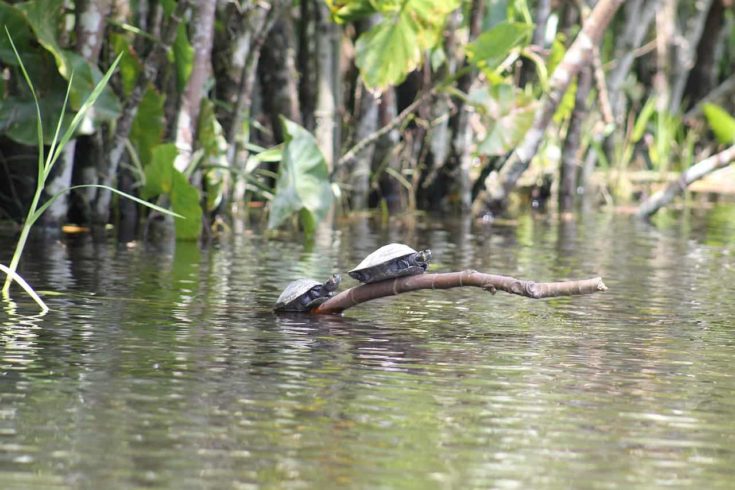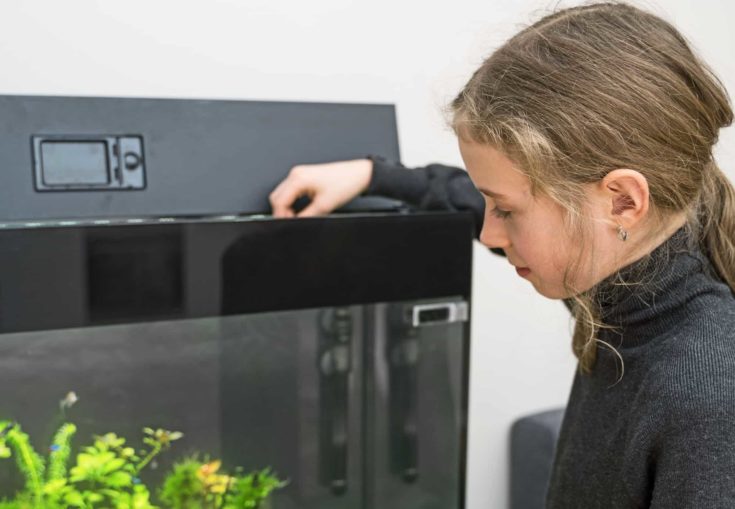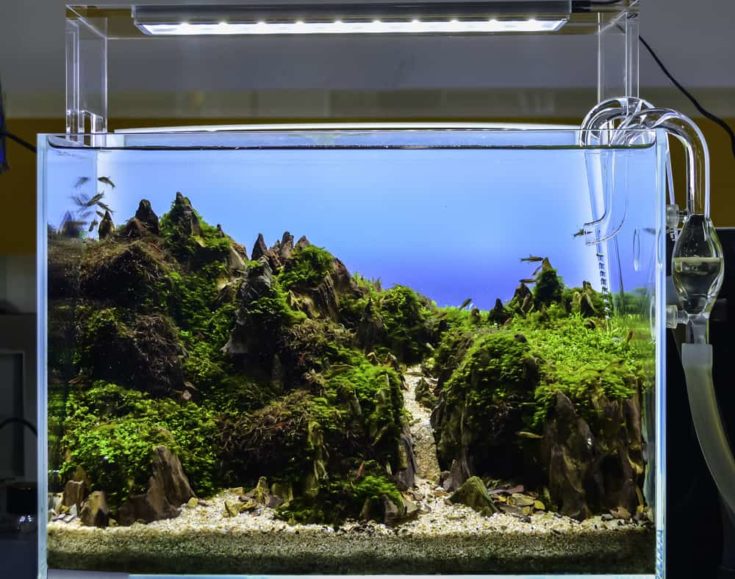The Kissing gourami (Helostoma temminkii) is a well-established favorite with many experienced aquarists, largely because of the fish’s fascinating behavior.
It’s the fish’s strange “kissing” action that makes them so intriguing and distinct. In fact, these gouramis are so unique that they are the only species in the genus. So, why do Kissing gouramis kiss?
Read this guide to find out everything you need to know about keeping these gorgeous tropical fish.
Kissing Gourami – Species Overview
Scientific Name
Helostoma temminkii
Common Name (species)
Kissing gourami, Kisser fish
Family
Helostomatidae
Origin
Vietnam, Thailand, Eastern Myanmar, Sumatra, Java, Borneo, Cambodia, Malay Peninsula
Diet
Omnivore
Care Level
Intermediate
Activity
Active
Lifespan
7 to 25 years!
Temperament
Semi-aggressive
Tank Level
Top to the middle of the water column
Minimum Tank Size
75 gallons
Temperature Range
Tropical 72° to 82° Fahrenheit
Water Hardness
5 – 20 dGH
pH Range
6.0 to 8.0
Filtration/Flow Rate
Good filtration and slow flow rate
Water type
Freshwater
Breeding
Egg-scatterer that can be bred in captivity
Compatibility
Semi-aggressive with smaller fish
OK, for Planted Tanks?
Safe with plants
Origins
Kissing gouramis are originally from Java, Indonesia. The fish are also found in Borneo, Malaysia, Cambodia, Vietnam, and Thailand.
The fish are actually cultivated in southern Indochina, Singapore, and Thailand as a food fish. Almost all the fish that you find for sale in the US are commercially raised in Florida.
Kissing gouramis are currently listed on the IUCN Red List as being of Least Concern.
Natural Habitat
Kissing gouramis live in shallow, slow-moving waters where the environment is heavily vegetated.

Wild kissing gouramis mostly feed on aquatic plants and benthic algae and also take insects that settle on the water surface. The fish are also filter feeders, using their gill rakers to sift plankton from the water.
What Do Kissing Gouramis Look Like?
The Kissing gouramis that you most often see for sale in your local fish store are pink or flesh-colored. You can also find a silver-green variety and there’s a piebald, mottled color morph too.
In nature, you mostly see the green version of the fish. The pink coloration is caused by a reduction in pigmentation and has been selectively bred for the trade. Green Kissers have a dark bar that borders the anal and dorsal fins, which is not present in the pink morph.
You can also find fish with shorter, rounder bodies that have a balloon-like appearance. However, this mutated strain is not as robust as the other variants and has a shorter life expectancy.
Kisser Fish
The Kissing gourami’s mouth is what sets it apart from other gouramis and is where the fish gets its common name.
The gourami’s lips are fleshy and thick and lined with fine teeth. The fish press their lips against aquarium surfaces, decorations, and plants to feed on debris and algae. Sometimes, the fish suck on the sides of their tank mates to ingest the mucus that the fish produce.
Labyrinth Organ
Like all gouramis, Kissing fish have a structure called a labyrinth organ.
The labyrinth organ enables the fish to breathe atmospheric air so that they can survive in water where the oxygen level is low. Labyrinth fish are typically not able to extract enough oxygen from the water, so it’s essential that the fish have clear access to the water surface.
Also, the ambient air temperature outside the aquarium must be the same as that within the tank, or the labyrinth organ might be damaged.
Size
Kissing gouramis can grow to reach 12 inches in length in the wild. However, in the captive environment, the fish usually only grow to half that size.
Life Expectancy
Kissing gouramis have a pretty long life expectancy, living for between seven and 25 years, depending on the care and diet they receive.
Activity Level/Temperament
Kissing gouramis are slow-moving fish that glide gracefully around the tank.
An intriguing behavior that you’ll observe is that the fish lock lips, facing each other and swimming slowly together. Both sexes indulge in that behavior. It’s not clear why the fish do that, but it’s thought to be a kind of semi-aggressive activity to do with social hierarchy. Although kissing doesn’t generally result in injury, it can cause stress to the weaker fish.
Compatibility and Tankmates
Tank Mates
Kissing gouramis are generally good community fish when they are small. However, adult specimens can be aggressive and are known to bully smaller fish and even larger ones.
Older, larger Kissing gouramis should be housed on their own or in a species tank. However, some individuals are more sociable and tolerant than others. You can keep Kissing gouramis together, provided that the tank is not overcrowded.
Suitable tank mates for Kissing gouramis include:
- Barbs
- Larger varieties of tetras
- Loaches
- Some cichlids
- Some species of catfish
You should avoid including fish that are aggressive, and fin nippers don’t mix well with Kissing gouramis. These fish are also highly skilled hunters, so very small fish or fish fry won’t survive for long in a tank with Kissing gouramis.
Diet and Nutrition
For healthy fish and vibrant colors, you should always feed your Kissing gouramis high-quality, nutritious foods.
What Should You Feed Your Kissing Gouramis?
Kissing gouramis are naturally omnivorous, eating a diet of meaty protein, algae, and some plant matter.

These fish use the rows of fine teeth inside their lips to graze on vegetable matter and algae. Tank-kept Kissing gouramis enjoy fresh lettuce, peas, and blanched zucchini, but the mainstay of their diet should be frozen, live brine shrimp, tubifex, and tropical flakes.
How Much and How Often to Feed Kissing Gouramis
I recommend that you feed your Kissing gouramis twice a day, offering only what the fish will clear in a few minutes.
Aquarium Requirements
Aquarium size

Kissing gouramis can grow to be pretty large fish, so you need to keep them in a tank of at least 75 gallons. You’ll need to add an extra gallon of water per inch of fish if you add more stock to your tank.
Because these fish are labyrinth breathers and surface feeders, they need constant access to the surface. The fish do best in a long tank that offers plenty of swimming space and allows good gaseous exchange to ensure that the water contains plenty of oxygen.
The tank should have a cover slide or lid, as Kissing gouramis can jump.
Tank Setup
Substrate
Gouramis are happy with any kind of substrate, although a dark sand or gravel works well to show off the fish’s colors.
Decoration
The Kissing gourami needs a tank that contains plenty of heavy planting with lots of caves, driftwood, and rockwork.
Habitat Requirements
Filtration
In nature, Kissing gouramis live in slow-moving water, so the most suitable filtration system is one that doesn’t create too much current. I recommend an external filter such as a HOB or canister system.
Water Parameters
Water Temperature
Kissing gouramis are a tropical species that need a water temperature of between 72° and 82° Fahrenheit.
Water Hardness and pH Range

The water pH should be between 6.0 and 8.8, with a water hardness in the range of 5 to 35 dGH.
Lighting
Regular tank lighting is fine for these fish, but if you’re concerned that the tank is too bright, you can temper the light by adding some floating plants.
Tank Maintenance
Kissing gouramis need a clean tank to remain healthy, so you’ll need to perform 20% to 25% water changes every week.

Every month, rinse the filter media through in some dirty tank water to remove any sludge that would otherwise clog the media and obstruct the water flow. Replace the media as directed by the manufacturer.
You should also vacuum the substrate to remove rotting organic products that will pollute your water if left to decompose.
Use an algae magnet to clean the viewing panes.
Setting Up Your Tank

Collect everything you need to set up your fish tank, including:
- Dark substrate
- Driftwood, rockwork, caves
- LED lighting unit
- Water conditioner
- HOB or canister filter unit
- Heater
- Aquarium thermometer
- A selection of live plants
How To Do It:
- Give the substrate a rinse to make sure it’s free from dust and debris.
2. Put several inches of the clean substrate into the tank to a depth of around three inches.
3. Plug in the filter and heater but don’t power them up yet.
4. Fill the tank with dechlorinated tap water just as far as the fill line. To prevent displacement of the substrate, pour the water over a smooth stone or upturned dish.
5. To start the nitrogen cycle, you need some ammonia in the water. You can either add a few drops of pure ammonia to the water or a pinch of fish food. Alternatively, a handful of gravel from an existing tank will do the job.
6. Rinse your tank decor and arrange it in the aquarium.
7. Snip off any damaged stems or dead leaves, and add your living plants to the aquarium.
8. Switch on the heater and filter. If the tank contains live plants, you’ll need to turn on the lighting unit for eight to ten hours a day, too.
The tank now needs to cycle fully before you can add any fish. That process can take between ten days and two months. Throughout that time, you need to test the water every day. The levels of ammonia and nitrite must be zero and nitrate should be under 20ppm for the water to be safe for your fish.
Once you’ve added your first few fish, keep testing the water. As long as the levels remain correct, you can add a few more fish.
Health and Disease
Signs of Good Health
Kissing gouramis are usually fairly placid creatures that spend their time foraging or grazing on algae growing on the tank surfaces.
Red Flags
Some signs of trouble to be aware of include:
- Not eating
- Not swimming around the tank
- Red streaks in the fins, bloody ulcers on the skin, red patches on the body
- Flashing against the substrate or solid objects within the aquarium
Common Health Issues and Treatments
Health Issue
Ich (White Spot Disease)
Symptoms or Causes
White spot is also known as Ich. The disease is caused by an aquatic parasite.
Infected fish flash against the substrate and tank decorations. As the disease progresses, a smattering of white dots develops across the fish’s fins, gills, and body.
Recommended Action
Increase the water temperature to 82o F for several days. Simultaneously, dose the tank with Ich medication.
Health Issue
Flukes
Symptoms or Causes
Flukes are external parasites that attach themselves to the fish’s body and gills. Species of flukes include fish lice, anchor worms, and flatworms.
Recommended Action
Treat the water with antiparasitic medication.
Health Issue
Fungal infections
Symptoms or Causes
White fluffy growths on the fish’s mouth, head, and body.
Recommended Action
Treat infected fish in quarantine with an antifungal medicine.
Health Issue
Bacterial infections
Symptoms or Causes
Reddened areas on the fish’s body, ulcers, ragged, bloody fins.
Recommended Action
Treat the aquarium with antibacterial drugs.
Breeding
You can breed Kissing fish in your home tank.
Unlike other species of labyrinth fish, such as bettas, Kissing gouramis don’t create bubble nests, although you might see them blowing bubbles randomly at the water surface. Instead, the female Kissing fish scatters hundreds or even thousands of eggs that the male fertilizes as they float to the surface.
When setting up the spawning tank, add a few floating plants or lettuce leaves before the fish spawn. The eggs will stick to the leaves, and the fry will feed on the infusoria that grows on the plant matter.
Once the fish have spawned, you’ll need to remove them so that they don’t eat the fry, which generally hatch within a day or so. You can feed the free-swimming fry with finely crushed flakes or tiny live foods, including baby brine shrimp.
Availability
Kissing gouramis are readily available to buy in fish stores, usually for around $12.
Recommended Products
- Algae magnet
- Aquarium thermometer
- Aquarium vacuum
- Books on caring for tropical fish
- HOB or canister filter
- Fish tank (minimum size 75 gallons)
- Heater
- High-quality tropical fish flakes, frozen food
- LED lighting unit
- Living plants
- Water dechlorinator
- Smooth stones, driftwood, rockwork, caves
- Dark-colored substrate
In Conclusion
Did you enjoy our care guide to the unique Kissing gourami? If you did, please share it with other fishkeeping enthusiasts!
Although these are not the most peaceful of the gourami species, Kissing fish can still make a fascinating addition to a large community tank that contains fish of a similar size. Temperamental issues aside, Kissing gouramis are relatively easy to care for and are pretty hardy, too.
If you keep Kissing gouramis, we’d love to hear about them! What other fish do you keep in the tank, and how does that work? Tell us in the comments box below.